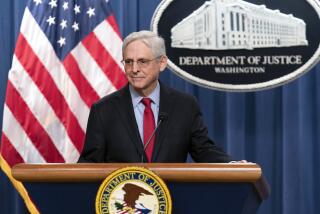U.S. Trial Against Tobacco Starts
WASHINGTON — The Justice Department’s huge racketeering case against the tobacco companies went to trial Tuesday, with government lawyers portraying the industry as an outlaw enterprise and demanding that cigarette makers forfeit $280 billion in allegedly ill-gotten gains resulting from a decades-long conspiracy.
The companies devised an “overarching scheme” to defraud the public, relying on “half truths, deceptions and outright lies” to distort the risks and addictiveness of smoking and fend off regulation and liability claims, declared Justice Department attorney Frank Marine.
The purpose was “making money, pure and simple,” while the result, Marine said, was that more than 400,000 Americans die each year from diseases caused by smoking and secondhand smoke -- more than the death toll from alcohol, AIDS, auto accidents, murders and suicides combined.
In five hours of opening arguments before U.S. District Judge Gladys Kessler, Marine and Justice Department attorney Sharon Y. Eubanks alleged a broad range of deceptive acts, using projector screens to display highlighted copies of about 100 of the more than 72,000 exhibits prepared for the case.
Many were internal documents from the 1950s to 1980s, in which tobacco executives and scientists bluntly affirmed what they always disputed in public: that smoking and secondhand smoke were dangerous, that they targeted teens to replace smokers who quit or died, that nicotine was a drug and that they consciously designed their products to optimize its addictive power.
The tobacco defendants, Philip Morris USA, R.J. Reynolds Tobacco, Brown & Williamson Tobacco, British American Tobacco, Loews Corp.’s Lorillard Tobacco and Vector Group Ltd.’s Liggett Group, will give their opening statements today.
The companies contend that they never engaged in fraud, and further, that their conduct has changed significantly since a 1998 settlement with the states required a higher level of candor and marketing restraint. The industry also argues that the racketeering law, known as RICO, does not provide for disgorgement of ill-gotten gains, unless there is a probability of the funds being used to commit fraud in the future.
The case is the largest civil racketeering suit in history, and $280 billion is the biggest sum ever sought by the Justice Department in a civil case. It has charged the companies with 145 specific acts of mail and wire fraud linked to specific ads, news releases and pamphlets disseminated to the public.
Along with the money -- which represents 30 years of gross profits, plus interest, from sales to 33 million smokers who took up the habit before the age of 21 -- the government is seeking stiff controls on the industry beyond those in a landmark settlement with the states.
The government claims the conspiracy began in December 1953, when the industry staged high-level meetings at the Plaza Hotel in New York, to devise a strategy for dealing with reports about the link between smoking and lung cancer.
What followed, Marine said, was “one of the most elaborate public relations schemes in history.”
Many exhibits listed by the government have surfaced in other tobacco trials. Some of these internal memos have been jokingly called “the greatest hits” because of the admissions they contain. But the Justice Department suit covers a wider range of alleged misconduct and industry documents than any previous case.
Filed under President Clinton, the case was inherited by the Bush administration, and many observers thought it would be dismissed or settled well before trial. On Tuesday, Atty. Gen. John Ashcroft issued a statement calling the case “an important effort to prevent fraudulent activity and uphold corporate integrity.”
More to Read
Inside the business of entertainment
The Wide Shot brings you news, analysis and insights on everything from streaming wars to production — and what it all means for the future.
You may occasionally receive promotional content from the Los Angeles Times.










